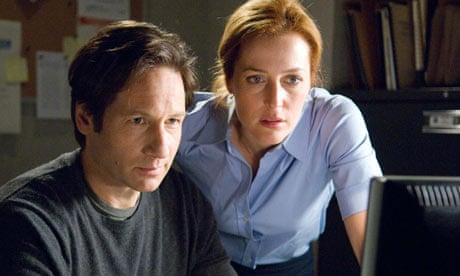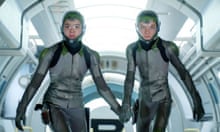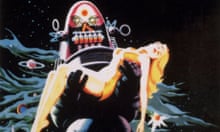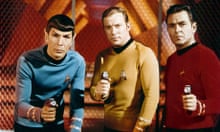We're living in a bit of a golden age of television right now, practically drowning in high-quality scripted shows. Think back to 1993, though: Quantum Leap was still on the air. So were Saved by the Bell, and Perfect Strangers. Walker, Texas Ranger and Beavis & Butthead made their collective debuts. It was a strange time, and the quality was spotty at best.
It was into that world, on 10 September, that Fox – desperate to secure a spot as the fourth major broadcast network in the US television market – launched The X-Files. The show would last nine seasons, 202 episodes and two feature films and cement the careers of series creator Chris Carter and actors David Duchovny and Gillian Anderson. (Not to forget writer Vince Gilligan, who will be at Comic-Con with the final season of Breaking Bad.)
And on Thursday morning, Carter, Duchovny and Anderson will join many of the show's writers – Gilligan, David Amann, Howard Gordon, Darin Morgan, Glen Morgan, John Shiban and Jim Wong – in ballroom 20 at San Diego Comic-Con to reminisce. I'm pretty sure the line outside is already packed.
Those of us left at home, though, can gather here to reminisce about our own favorite episodes. These are mine, though they're probably not all yours. What was your favorite? Tell us in the comments below.
Pilot, 10 September, 1993
I was 12 then, and at school the next morning learned I had been one of two kids in my entire eighth-grade class whose parents allowed them to stay up past 10 to watch this new science-fiction show on Fox. So thanks for that, mom and dad. I think I've only recently stopped having nightmares about aliens in the woods.
"First and foremost, what I wanted to do was scare people's pants off," says series creator Chris Carter in the interview below. "I wanted Mulder, the male, to be the believer, the intuiter, and I wanted Scully to be the skeptic, which is usually the male role."
Squeeze, 24 September, 1993
The third episode introduces Doug Hutchison as serial killer Eugene Victor Tooms, one of the series' most memorable monsters. (The two episodes in which Hutchison appeared cemented his "oh, that guy" status as a mostly forgettable American TV actor, until a decade later when he would show up on Lost and then marry a teenager less than half his age, at which point "oh, that guy" took on a decidedly more alarmed tone.)
But back then, he was just this ageless mutant with a taste for blood who emerges every few decades to commit murder. Squeeze was the first of the show's monsters-of-the-week episodes, which stood apart from the overarching mythology that was to be its incredibly confusing undoing years later.
The episode also reinforces one of the central conceits of the Mulder-Scully partnership: how, exactly, do two FBI agents collect evidence to prosecute criminals – which is ostensibly what their job is supposed to be about – when the evidence includes 100-year-old fingerprints belonging to the ageless mutant sitting over there in the interrogation room?
Bonus: Donal Logue co-stars as the Baltimore FBI agent who calls the team in.
Ghost in the Machine, 29 October, 1993
The 1990s were a funny time in computer culture. We were all getting online, but most of us were confused about what, exactly, was going on inside those big gray boxes. This was the era of Hackers, of The Net, of Lawnmower Man, films that exploited our fears of the machines. Ghost in the Machine exploits those same fears by presenting an artificial intelligence that has started killing people at a tech company Alexandria, Virginia. Mulder and Scully investigate, apparently showing no fear in the face of a deadly, deadly elevator.
Eve, 10 December, 1993
From The Shining to The Ring, cute little girls are easily exploited to nightmarish effect in the horror genre. The X-Files' entry into this canon is Eve, a cloned child with superhuman intelligence who likes to kill grown-ups.
Possible deduction of points: the episode inspired the name of the band Eve 6, which is 90s nostalgia writ wrong.
Darkness Falls, 15 April 1994
The X-Files liked to play off our fear of technology, but what happens when you're so far into the woods that none of the technology works? The car's acting up, and there are no phones, no radios – and suddenly no lights because your power generator is failing and these weird firefly-like moths that may or may not be killing loggers are now closing in on your one-room cabin?
Mulder and Scully have been sent to investigate the disappearance/deaths of a crew of loggers who are illegally taking down ancient trees in the Pacific Northwest, one of which happens to have been home to 500-year-old bugs that are now unleashed upon the camp. The team end up nearly dying, cocooned in the moths' web inside a Jeep as their escape attempt fails.
Home, 11 October, 1996
Yeah. This one. Just … go read about it here. I can't.
Musings of a Cigarette Smoking Man, 17 November, 1996
Pity the poor Smoking Man, a rejected, disgruntled writer who was forced – forced! – to cast his dreams aside and become the head of a secretive shadow government determined to keep the truth from Mulder.
The episode reveals Mulder's nemesis/slash/mentor as something of a Forrest Gump of American government conspiracies, firing the shot that killed Kennedy, assassinating Martin Luther King, making the Bills win a Super Bowl, and orchestrating the US hockey team win during the Miracle on Ice by drugging a Soviet goaltender. All along he just wanted to write.
Bonus: more Lone Gunmen.
Unusual Suspects, 16 November, 1997
Proof that I don't hate all mythology episodes, look! It's the Lone Gunmen, meeting Mulder for the first time at a computer security conference in Baltimore. And who's that over there? Is that Munch from Homicide? Yes, it is. Hi, Richard Belzer.
Basically, the US Defense Department is storing an untested gas in asthma inhalers in a warehouse in Baltimore, and a mysterious woman is being tracked by a chip in her tooth, and Mulder strips naked and has hallucinations about aliens, which, let's face it, could be what the whole series has been about anyway. Vince Gilligan wrote this one. Again.
Bad Blood, 22 February, 1998
As scary as the show could be in episodes like Home, it could also showcase a wickedly wry sense of humor. Vince Gilligan also penned this monster-of-the-week episode in which Mulder kills a teenage boy who thinks Mulder is a vampire. Like many of the standalone, non-mythology episodes, it's decidedly more humourous.
Gillian Anderson herself recently told Huffington Post that Bad Blood was among her favorites, saying: "I just have to think about that episode and I start to laugh".
Bonus: Luke Wilson. I think Anderson's feelings on the matter are pretty clear from the clip below.
The Pusher, 23 February, 1996
Yep, it's another Vince Gilligan episode, this time about a "pusher" who can talk people into committing crimes or killing themselves. Slate recently plucked this episode out as the one to watch if you're looking to get into the series anew:
And here's where The X-Files remains, in some ways, ahead of its time, even now. Despite the central mythology's very bad men planning very bad things, the show focuses on an idea of evil as essentially banal, accessible, part of our everyday world.
Post-Modern Prometheus, 30 November, 1997
A black-and-white, comic-book-themed standalone episode, this is the X-Files at its absolute very best. It was nominated for seven Emmys in 1998, is based heavily on Frankenstein, stars Jerry Springer as himself, and was written by Chris Carter himself as an ode to Cher. And it ends with Mulder and Scully dancing together.
Chinga, 8 February, 1998
Throughout the show's run, plenty of famous writers took a crack an an episode. This is Stephen King's, and it's about a horrifying evil doll patched together from parts of other dolls and determined to scare the crap out of a little girl and those of us watching the episode.
Improbable, 14 April 2002
As might be obvious here, the show's later episodes were but a pale flicker of light compared to the earlier seasons. Duchovny left, and Anderson scaled back her appearances, and the show added Robert Patrick and Annabeth Gish as Not Mulder and Not Scully. One of the few beacons in this dark time was this final-season episode in which a killer … um … uses numerology? To kill people? Whatever, Burt Reynolds plays God.










Comments (…)
Sign in or create your Guardian account to join the discussion